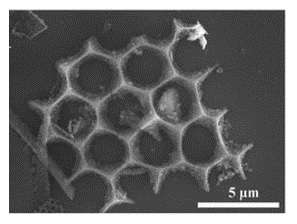Page 1 of 1
Man made?
Posted: Thu Jun 13, 2019 4:21 pm
by 75RR
Found this in a freshwater sample. Holes are 12µm diameter
Re: Man made?
Posted: Thu Jun 13, 2019 5:15 pm
by PeteM
Sure looks like it. Perhaps part of a filter (oil, air, water, . . .) ??
Might be part of something like a micro-perforated bag (used for bread etc.)?? Not quite the same look, though.
It also seems that bits of plastic are showing up everywhere in nature. If the substrate is thermoplastic, should melt with some heat.
Anything else revealed at higher magnification?
Re: Man made?
Posted: Thu Jun 13, 2019 5:32 pm
by Hobbyst46
I would place a magnet near it, to check the suspicion that it contains iron (and/or nickel).
Re: Man made?
Posted: Thu Jun 13, 2019 6:10 pm
by 75RR
Thanks PeteM and Hobbyst46.
Thought it might be, though I was hoping it would be something natural and therefore exotic.
I am afraid that was all I found. Did not think to keep the sample and have since washed the slide.
Total length was not much over 160µm so I would have struggled to run tests on it.
Will keep an eye out for larger pieces.
Re: Man made?
Posted: Thu Jun 13, 2019 8:10 pm
by MicroBob
Hi together,
I think about which production process can lead to such a small holed pattern. Difficult to make a punch like this, injection moulding would be difficult too. Laser cutting, etching?
For a filter one would use a mesh or felt.
In electronics such fine (and much finer) shapes are used - separator of an electrolyte capacitor?
Bob
Re: Man made?
Posted: Thu Jun 13, 2019 8:25 pm
by PeteM
Bob - for some of the plastics, a process similar to calendaring can be used to make micro holes. Cheers, P.
Re: Man made?
Posted: Thu Jun 13, 2019 8:28 pm
by MichaelG.
Re: Man made?
Posted: Thu Jun 13, 2019 9:01 pm
by Hobbyst46
Compared to the forams and radiolaria that I have seen so far (very few, unforetunately) the mesh pattern on this dark piece of sample appears to be too uniform to be natural.
Re: Man made?
Posted: Thu Jun 13, 2019 9:52 pm
by PeteM
This one kind of takes us full circle; from diatoms to microporous battery anodes. Not likely the original found material, but still cool:
https://phys.org/news/2016-10-ancient-f ... cient.html
And yet another technique to replace lithographic substrates:
https://pubs.rsc.org/en/content/article ... ivAbstract
And then there's "biochar" - vaguely similar and possibly likely to be made in some industrial-scale process in the future:
https://biocharlie.com/blogs/news/70415 ... althy-soil
Re: Man made?
Posted: Fri Jun 14, 2019 12:42 pm
by 75RR
Agree that it is probably not the one but yet it is the closest in regularity i.e. hole diameter and spacing, I would say.

Re: Man made?
Posted: Fri Jun 14, 2019 6:50 pm
by Peter
Hi 75RR,
It could be the remains of an insect's compound eye. On the lower right corner of the object I imagine I can see lenses bulging from the holes.
Peter.
Re: Man made?
Posted: Sat Jun 15, 2019 4:23 am
by 75RR
Thanks Peter
It could be the remains of an insect's compound eye. On the lower right corner of the object I imagine I can see lenses bulging from the holes.
I noticed that as well - tried to include it in the stack. However, the only close-up images of insect eyes that I have found seem to be hexagonal - though they are also remarkably regular in size and placing.
Having said that I found one that looks interesting (scroll down to red eye)
https://www.dreamstime.com/photos-image ... d-eye.html